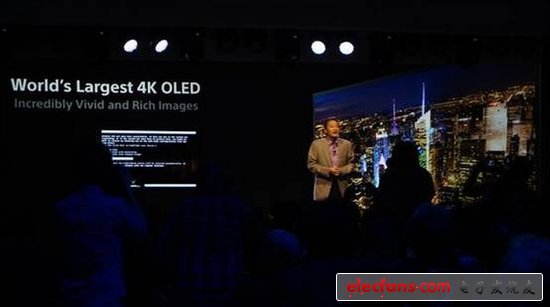The Road to 2160p Ultra HD: How 4K TV Enters the Homes of Common People
There are many problems that hinder the popularization of 4K, and the price is only one of them; to enter the living room of civilians, the 4K standard must overcome these obstacles. The following is an analysis of the tested.com website: 4K (Ultra High Definition Video Format) is a major theme at this year's CES exhibition, and TV manufacturers hope to use it to eliminate our current high-definition TV. Due to the increased display pixel density, under the same physical size, the image of the 4K TV will be clearer, sharper and more delicate-just like the case of tablet computers and mobile phone displays.

But the focus of many people is the price of 4K TVs. This kind of equipment is really expensive. The price of some early models was 25,000 US dollars (about 156,000 yuan), so it is impossible to enter the general family quickly, but if you think the price is the only obstacle it faces, it is wrong. .
The price is just one of many obstacles facing 4K TVs. In the absence of 4K content, what is the real benefit of Ultra HD compared to HD, this is also a problem.
Some reports from CES may make you think 4K is within reach, but in fact it is still just a dream. To realize this dream, many things including the habits of consumers, manufacturers and content producers need to change. Let's take a look at how TV manufacturers define 4K, where consumers will get 4K content, and the truth about double-line processing of 1080p video.
What exactly is 4K?
Now, you may have heard the word "Ultra HD" (Ultra HD, Ultra High-DefiniTIon). "Super" refers to the improvement of "High Definition", but how much difference does it need to add an adjective in front of "High Definition"?
As you may already know, it is related to pixels. HD refers to 1920 & TImes; 1080 pixels. UltraHD has more pixels, about 4 times that of HD. This means that the resolution of UltraHD is 4 times that of general 1080p HD video. Many times people call it 4K for short.
The American Consumer Electronics Association (CEA, CES is their organization) established a working group last year to discuss the marketing and naming of 4K technology. After obtaining the unanimous consent of the CEA "Industry Leaders" committee (composed of executives of large technology companies promoting 4K technology), the working group named it UltraHD.

For what is UltraHD or 4K, the working group has also made a clear definition: the resolution of the TV, monitor and projector must be at least 3840 x 2160 pixels, and the aspect ratio is at least 16: 9. This minimum requirement is very important because it also includes the display of 4096 x 2160 pixels (many 4K movie projectors and some TVs use this standard) under the name of UltraHD.
In other words, 4K contains two different resolutions, but they are also similar.
Of course, the real question is how big is the difference between UltraHD and 1080p HD devices? When you sit more than 6.5 feet (about 2 meters), the average person ’s eyes cannot distinguish a single pixel on a 50-inch high-definition TV. Imagine how close you are to a 4K TV for maximum enjoyment What are its benefits? (The answer is super close).
In fact, the difference between watching things on high-definition and UltraHD TVs is just like watching the differences between old Apple phones and ReTIna displays. The pixel density has increased, and there are more pixels on the same size screen. The result is that the image looks sharper and more detailed-especially when viewed at close range. This kind of experience is difficult to express with words or pictures. You need to go to the store to see for yourself.
What kind of 4K TV will be available this year
At last year's CES, 4K was one of the hot spots of discussion, but apart from a few manufacturers and some prototypes, there are very few UltraHD TVs that are really launched, and their prices are not the same as a small car. On a par.
By this year, 4K devices are still very expensive, and it is impossible to appear in your home soon. But with the increase in specifications and models, their prices have also declined.
Sharp released two UltraHD TVs, 60-inch and 70-inch, and a 32-inch UltraHD computer display. LG showed 55-inch and 65-inch models, of which 55-inch will be shipped in March, the price is 12,000 US dollars (about 75,000 yuan). Last fall, LG already sold 84-inch models in the US market with a suggested retail price of $ 20,000. (LG told the media that five months after the device was launched in South Korea, they sold about 300 units).

Sony showed 55-inch and 65-inch UltraHD TVs. Although the details have not been announced, their prices should be more approachable. The company also showed an 84-inch display launched last year, priced at $ 25,000. Panasonic showed a 56-inch OLED UltraHD TV and a 20-inch 4K Windows 8 tablet.
Vizio demonstrated 55-inch, 60-inch, and 70-inch 4K TV sets. The company, like Sony, also claimed to be "a technology innovator that brings this expensive new technology to mainstream consumers." Toshiba released a 55-inch UltraHD TV at CES last year, and this year showed 58-inch, 65-inch and 84-inch models.
However, the most impressive 4K display at CES this year is still from Samsung: this is a "floating frame" 85-inch TV (the display is hung in a modernist frame and is known as both furniture and artwork ). South Korean media said it will only pre-sell 77 units, each "400,000 won, about 37,900 US dollars (about 236,000 yuan)." This TV is also available in 95-inch and 110-inch versions, but I do n’t know when it will be released.
We can easily see some trends from the above information: most manufacturers choose huge 84-inch or 85-inch (or larger) devices as their flagship models, while the mainstream models are 55-inch or 60-inch. Except for a few vertical market products-namely Panasonic's 20-inch ultra-high-definition tablet PC and Sharp's 32-inch computer display-all 4K displays are biased towards large sizes. Since the human eye cannot distinguish a single pixel on a general high-definition display a few feet away, the market for 30-inch or 40-inch ultra-high-definition TVs is not very large (at least in the manufacturing cost of these sizes of 4K TVs and traditional HD TVs This was the case without comparability).
Ac Power Supply,Ac Dc Power Supply,Dual Rail Power Supply,18V Ac Power Supply
Yangzhou IdealTek Electronics Co., Ltd. , https://www.idealtekpower.com
